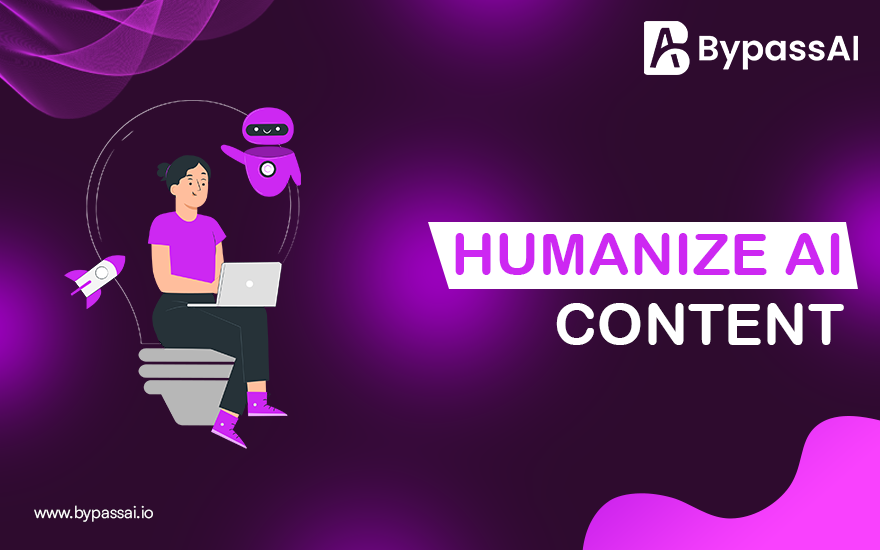Ever thought about how it feels to talk to your computer or phone, and it feels like you’re talking to a real person? This is what Humanize AI is all about. It’s like adding a human touch to technology. No more robotic replies. Instead, we get conversations that feel real and personal.
Imagine chatting with customer support, and they sound like they care. Or reading content online that feels like a real person wrote it. That’s what Humanize AI is trying to do. It’s about making our digital experiences more personal, more relatable, and less mechanical.
Quick Summary
In this blog, we’ll explore what Humanize AI is, why it’s important, and how tools like Bypass AI are leading the way. We’ll also see how these tools are changing content creation, customer service, and more. By the end, you’ll get why adding a human touch to AI is a game changer.
What is Humanize AI?
Humanize AI means making artificial intelligence act more like a real person. It helps AI to understand and respond to emotions, tone, and context. This makes interactions feel more natural and less like talking to a machine.
Think about it. When you talk to Siri or Alexa, they sound robotic. But what if they could understand your feelings? And respond in a way that makes sense? That’s what Humanize AI text is trying to achieve. It’s about creating a smoother, more engaging experience for everyone.
Why is Humanizing AI Important?
- Improving User Experience:
When AI feels human, using it becomes more enjoyable. People are more likely to trust and use technology that understands them.
- Building Trust:
Realistic interactions help build trust. When AI responds appropriately to our emotions, we feel more comfortable relying on it.
- Reducing Frustration:
No one likes talking to a robot that doesn’t understand them. Humanizing AI helps reduce frustration by providing more accurate and relatable responses.
- Enhancing Engagement:
Engaged users are happier users. Human-like AI keeps users engaged by making interactions feel personal and meaningful.
- Fostering Acceptance:
The more natural AI feels, the more likely people are to accept it into their daily lives. This helps AI technology reach its full potential.
Types of Humanized AI
- Emotion AI
Emotion AI helps AI systems recognize and respond to human emotions. It makes interactions more empathetic and less mechanical.
- Conversational AI
This includes chatbots and virtual assistants that can hold real conversations. They feel more human and help users better.
- Contextual AI
Contextual AI understands the situation and background of a conversation. It provides responses that make sense in the moment.
- Ethical AI
Ethical AI focuses on fairness and transparency. It ensures AI decisions are clear and trustworthy.
- Social AI
Social AI helps AI interact like humans do in social settings. It makes conversations feel more natural and relatable.
The Future of AI: Why Humanizing Matters
AI is becoming a bigger part of our lives. From customer service chatbots to content creation tools, we see AI everywhere. But most AI feels robotic. It doesn’t understand us. Humanizing AI makes these tools more useful and enjoyable. It helps them fit better into our daily lives.
As AI grows, making sure it feels human is super important. This way, we can trust it more, use it better, and let it help us in real ways. The future of AI should feel like talking to a smart friend, not a cold machine.
How to Humanize AI
- Emotion Recognition
AI needs to recognize how people feel. This helps it respond in a way that makes sense. For example, if someone is upset, AI can provide a calming response.
- Natural Language Processing (NLP)
NLP helps AI understand and use everyday language. This makes conversations feel real. AI can pick up slang and casual talk.
- Personalization
AI should know who it’s talking to. Personalized responses make interactions feel tailored and special. It shows AI understands the user.
- Ethical Considerations:
AI must be fair and transparent. Ethical AI builds trust. People feel more comfortable when AI is honest and unbiased.
- Continuous Learning
AI should keep getting better. Continuous learning helps it improve responses over time. This makes interactions more accurate and helpful.
Humanizing AI in Content Creation
Content creation is where Humanize AI text tools shine. Tools like Bypass AI help create content that sounds like a real person wrote it. This makes the content more engaging and relatable. It helps businesses connect better with their audience.
When AI creates human-like content, it feels more personal. Readers trust it more. They pay attention more. Whether it’s writing blogs, emails or social media posts, humanized AI makes the process faster and the results better.
Benefits of Humanized AI
- Enhanced User Experience:
AI feels more human. It responds better. Users enjoy interacting with tools that understand them.
- Increased Trust and Credibility:
People trust AI that acts like humans. It’s more reliable and less robotic. This makes users feel comfortable.
- Better Customer Service:
Customer support AI can solve problems faster and more empathetically. This leads to happier customers.
- Improved Engagement:
Users stay more engaged with content and conversations that feel personal. AI keeps their attention better.
- Higher Efficiency:
Humanized AI saves time. It provides better responses and handles tasks more accurately.
- Increased Efficiency and Productivity:
AI helps people work faster. It handles tasks smartly and provides quick answers.
Use Cases for Humanized AI
- Customer Service
Chatbots that feel human help customers get better support. They solve problems quickly and provide helpful answers.
- Healthcare
Emotion AI helps doctors understand patients better. AI can even predict patient needs. This improves care.
- Education
AI tutors that feel human make learning more fun. They provide personalized help to students.
- Marketing
Humanized content tools create relatable ads and posts. This connects better with customers.
- Gaming
Social AI makes characters more realistic. It creates a better gaming experience for players.
Tools that Humanize AI
1. Bypass AI
This tool creates human-like content for students and professionals. It helps with assignments, blogs, and more.
2. Grammarly
It doesn’t just check grammar. It gives feedback like a real editor would. It helps improve writing tone and style.
3. HubSpot
Their conversational tools make customer interactions feel personal. It helps businesses connect better with customers.
4. Zendesk
Their AI-driven support provides empathetic and accurate responses. It makes customer service more human.
Conclusion
Humanizing AI is about making technology feel real and relatable. Tools like Bypass AI are leading the way by creating content that connects. As AI becomes a bigger part of our lives, adding a human touch is more important than ever. This helps AI feel less robotic and more like a smart friend we can trust and talk to.
FAQs
- What is Humanize AI?
Humanize AI is about making AI feel more human. It helps AI understand emotions and respond like a real person.
- Why is Humanizing AI important?
It improves user experience, builds trust, and makes interactions less frustrating. This helps AI technology reach its full potential.
- What tools help humanize AI?
Tools like Bypass AI, Grammarly, and HubSpot help. They create human-like content and provide smart, relatable responses.
- How does Humanizing AI help content creation?
It makes content feel more personal and relatable. This helps businesses connect better with their audience.


